интонация_китайский универ.ppt
- Количество слайдов: 31

Better English Pronunciation for Communication A Practical Course for Students of English Wang Guizhen Faculty of English Language & Culture Guangdong University of Foreign Studies 1

Unit 14 Intonation Units of English 2
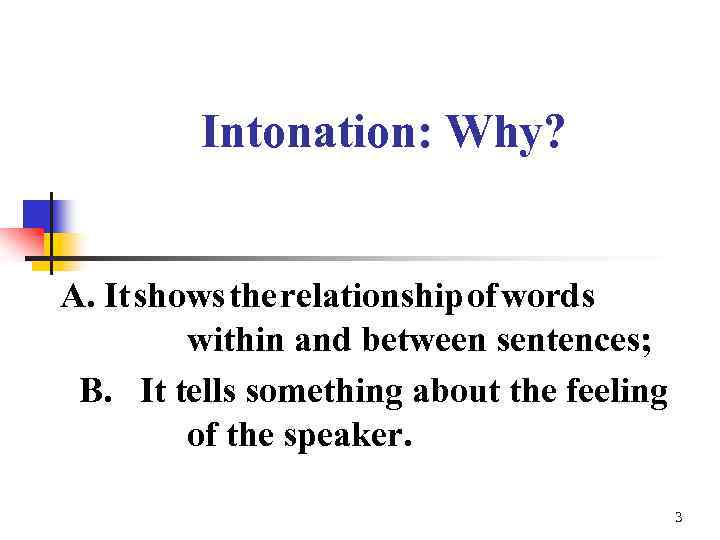
Intonation: Why? A. It shows the relationship of words within and between sentences; B. It tells something about the feeling of the speaker. 3
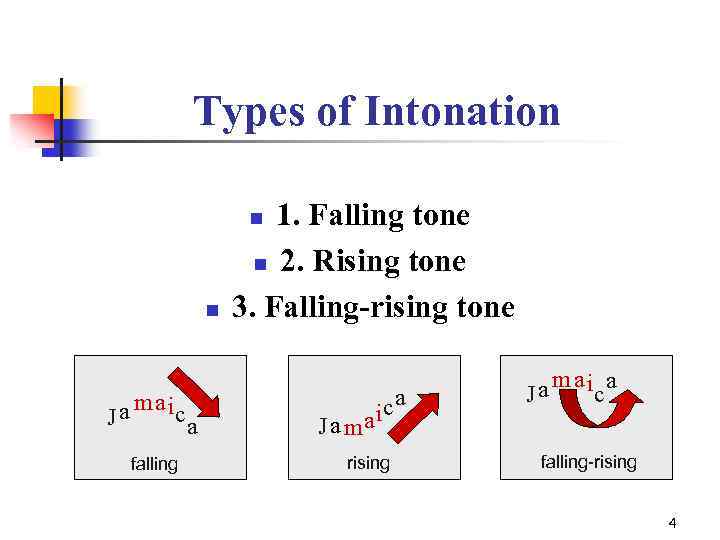
Types of Intonation 1. Falling tone n 2. Rising tone 3. Falling-rising tone n n a m a ic J falling a J a ma ca i rising a m a ic a J falling-rising 4

Reading aloud – Read the following using appropriate intonation n n Selling an Old House A man was tired of living in his old house in the country and wanted to sell it and buy a better one. He attempted to sell it for a long time, but was not successful, so at last he decided to solve the problem by using a real estate agent. The agent promptly advertised the house and a few days later, the owner saw a very attractive photograph of the house, with a wonderful description of its gardens, in an expensive magazine. After he read the advertisement through, the house owner hastened to telephone the real estate agent. “I’m sorry, Mr. Jones, ” said the man, “ but I’ve decided not to sell my house after all. Do you know why? After reading your advertisement in that magazine, I can see that it’s exactly the kind of house I’ve wanted to live in all my life. ” 5

Reading aloud – Pay special attention to the appropriate use of intonation. . n n n n A man was tired of living in his old house in the country. He wanted to sell it and buy a better one. He attempted to sell it for a long time. He was not successful. He decided to solve the problem by using a real estate agent. The agent promptly advertised the house. The owner saw a very attractive photograph of the house. He saw a wonderful description of his gardens. He saw the advertisement in an expensive magazine. He read the advertisement through. The house owner hastened to telephone the real estate agent. “I’m sorry, Mr. Jones, ” he said. Do you know why? I’ve decided not to sell my house after all. It’s exactly the kind of house I’ve wanted to live in all my life. 6

Do the following exercises online. Introduction Nucleus & intonation Intonation Nucleus What information Get information Say after me http: //felc. gdufs. edu. cn/pronunciation/ 7
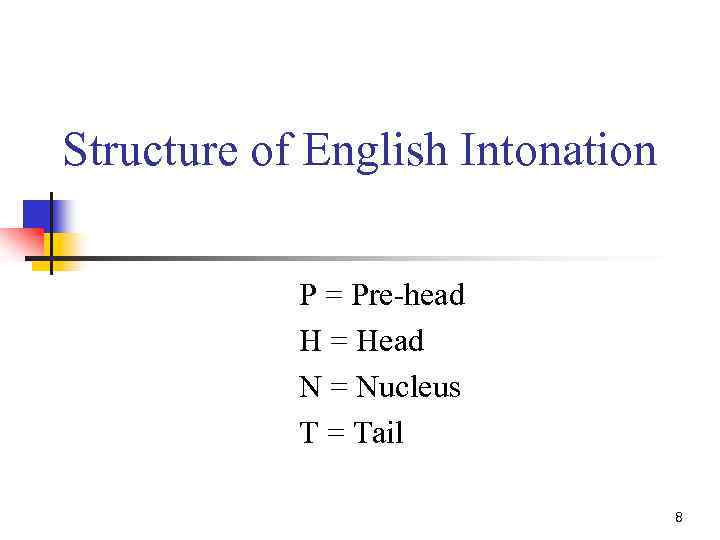
Structure of English Intonation P = Pre-head H = Head N = Nucleus T = Tail 8
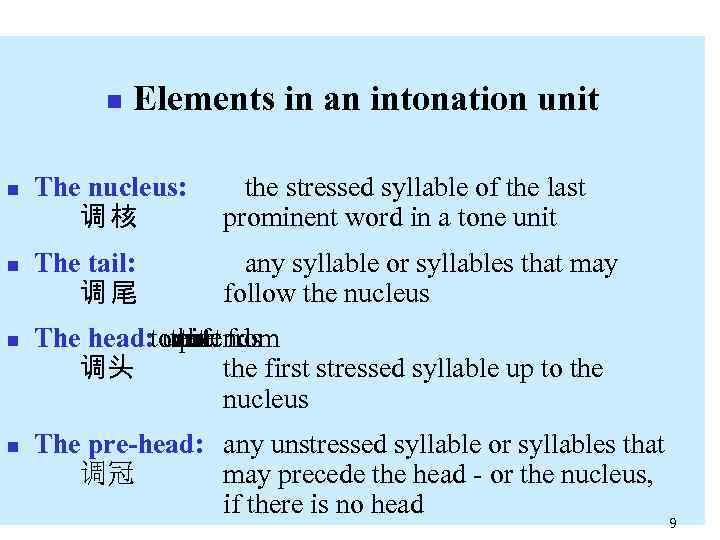
n n n Elements in an intonation unit The nucleus: 调核 the stressed syllable of the last prominent word in a tone unit The tail: 调尾 any syllable or syllables that may follow the nucleus The head: tone from unit that aof extends part the 调头 the first stressed syllable up to the nucleus The pre-head: any unstressed syllable or syllables that 调冠 may precede the head - or the nucleus, if there is no head 9

We are learning a foreign language. n n n We are LEARNing a FOReign LANGuage. P H N T P = Pre-head H = Head N = Nucleus T = Tail 10
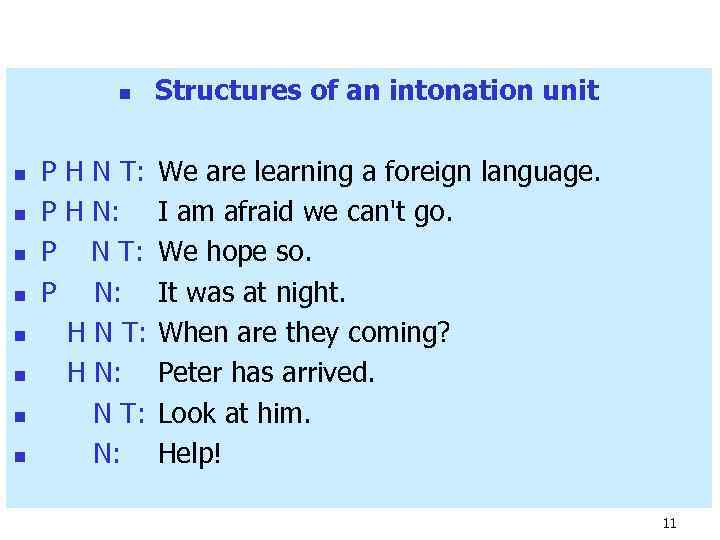
n n n n n P H N T: P H N: P N T: P N: H N T: H N: N T: N: Structures of an intonation unit We are learning a foreign language. I am afraid we can't go. We hope so. It was at night. When are they coming? Peter has arrived. Look at him. Help! 11
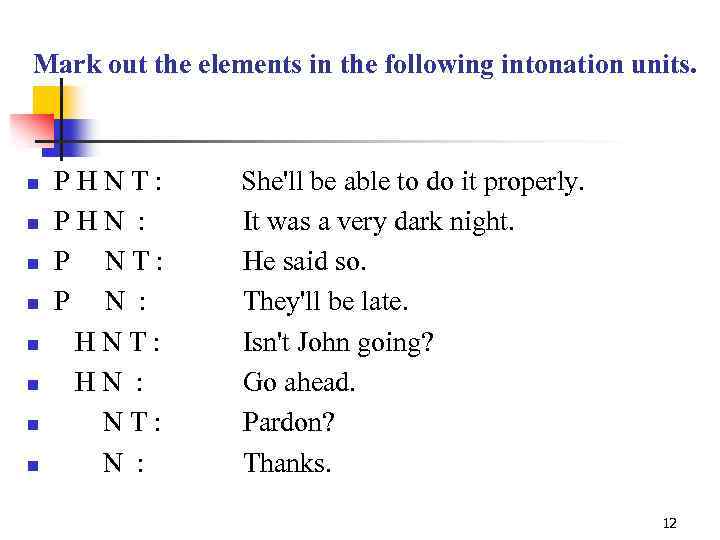
Mark out the elements in the following intonation units. n n n n PHNT: PHN : P NT: P N : HNT: HN : NT: N : She'll be able to do it properly. It was a very dark night. He said so. They'll be late. Isn't John going? Go ahead. Pardon? Thanks. 12
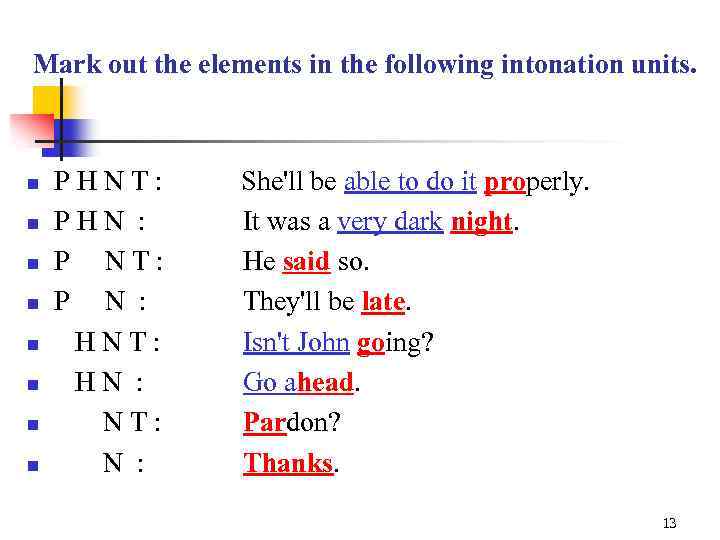
Mark out the elements in the following intonation units. n n n n PHNT: PHN : P NT: P N : HNT: HN : NT: N : She'll be able to do it properly. It was a very dark night. He said so. They'll be late. Isn't John going? Go ahead. Pardon? Thanks. 13
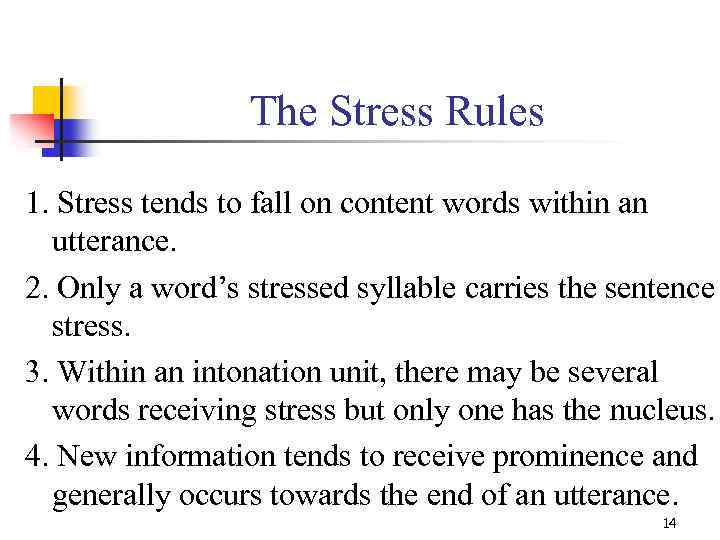
The Stress Rules 1. Stress tends to fall on content words within an utterance. 2. Only a word’s stressed syllable carries the sentence stress. 3. Within an intonation unit, there may be several words receiving stress but only one has the nucleus. 4. New information tends to receive prominence and generally occurs towards the end of an utterance. 14
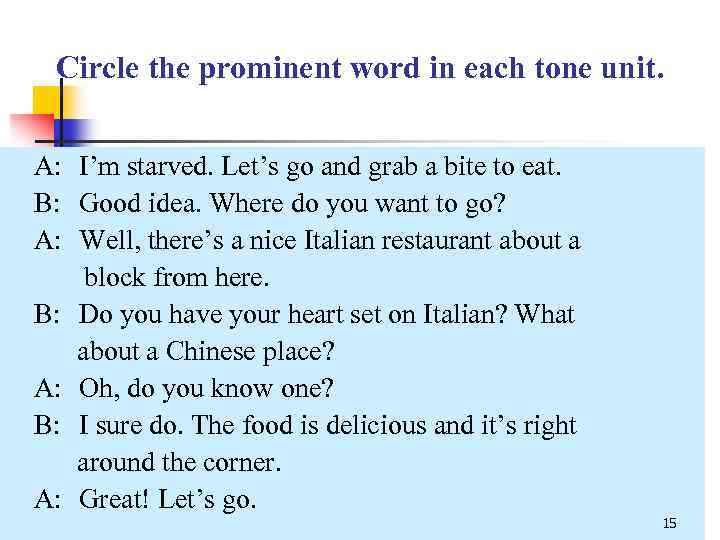
Circle the prominent word in each tone unit. A: I’m starved. Let’s go and grab a bite to eat. B: Good idea. Where do you want to go? A: Well, there’s a nice Italian restaurant about a block from here. B: Do you have your heart set on Italian? What about a Chinese place? A: Oh, do you know one? B: I sure do. The food is delicious and it’s right around the corner. A: Great! Let’s go. 15
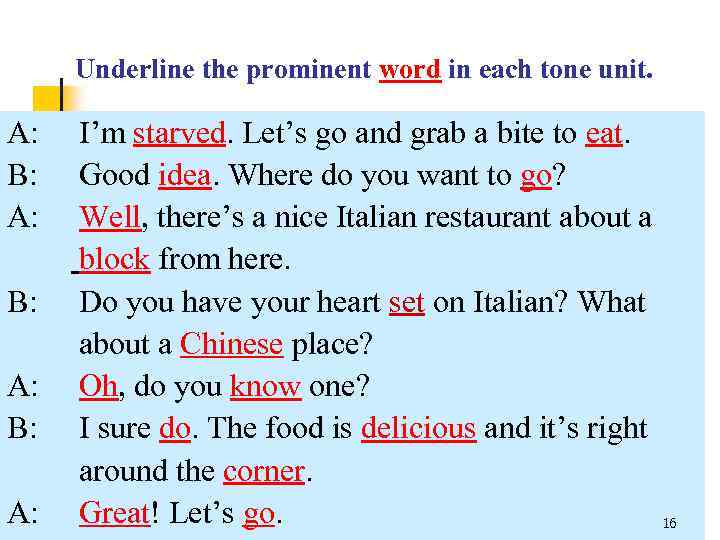
Underline the prominent word in each tone unit. A: B: A: I’m starved. Let’s go and grab a bite to eat. Good idea. Where do you want to go? Well, there’s a nice Italian restaurant about a block from here. Do you have your heart set on Italian? What about a Chinese place? Oh, do you know one? I sure do. The food is delicious and it’s right around the corner. Great! Let’s go. 16
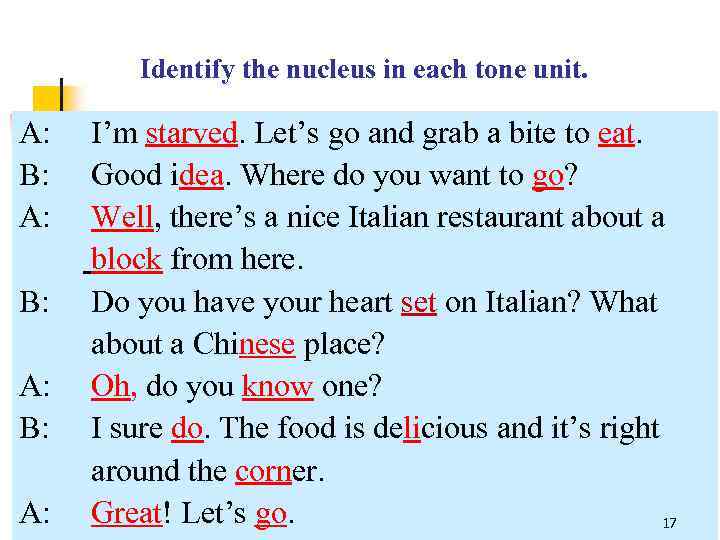
Identify the nucleus in each tone unit. A: B: A: I’m starved. Let’s go and grab a bite to eat. Good idea. Where do you want to go? Well, there’s a nice Italian restaurant about a block from here. Do you have your heart set on Italian? What about a Chinese place? Oh, do you know one? I sure do. The food is delicious and it’s right around the corner. Great! Let’s go. 17
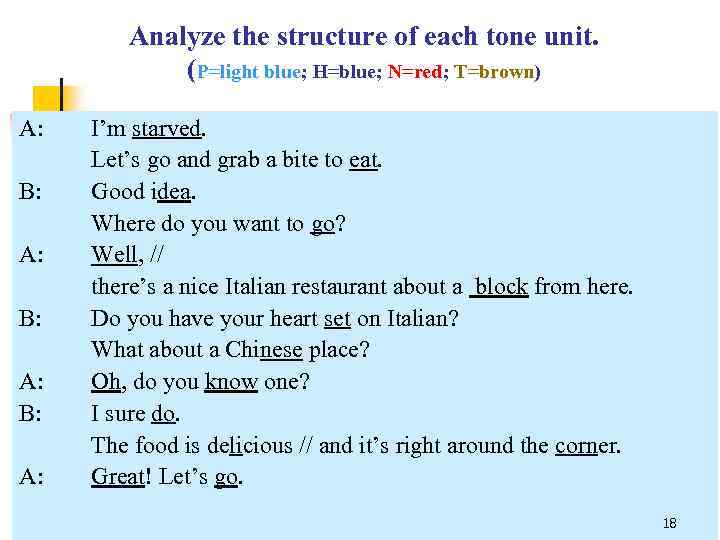
Analyze the structure of each tone unit. (P=light blue; H=blue; N=red; T=brown) A: B: A: I’m starved. Let’s go and grab a bite to eat. Good idea. Where do you want to go? Well, // there’s a nice Italian restaurant about a block from here. Do you have your heart set on Italian? What about a Chinese place? Oh, do you know one? I sure do. The food is delicious // and it’s right around the corner. Great! Let’s go. 18
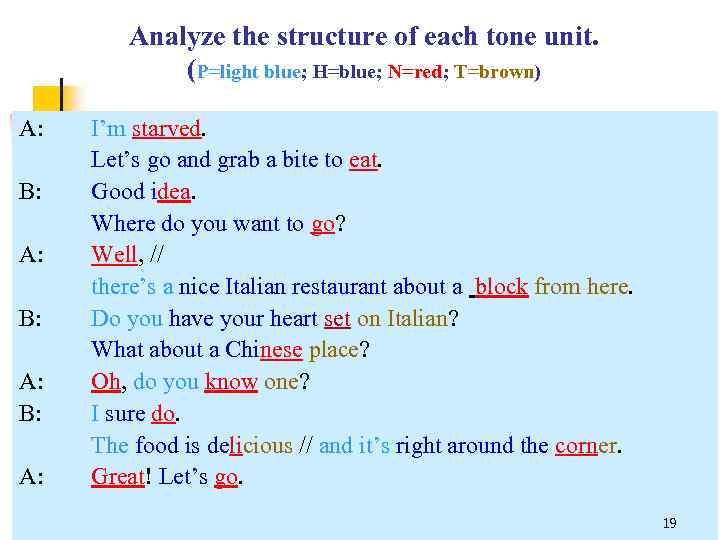
Analyze the structure of each tone unit. (P=light blue; H=blue; N=red; T=brown) A: B: A: I’m starved. Let’s go and grab a bite to eat. Good idea. Where do you want to go? Well, // there’s a nice Italian restaurant about a block from here. Do you have your heart set on Italian? What about a Chinese place? Oh, do you know one? I sure do. The food is delicious // and it’s right around the corner. Great! Let’s go. 19
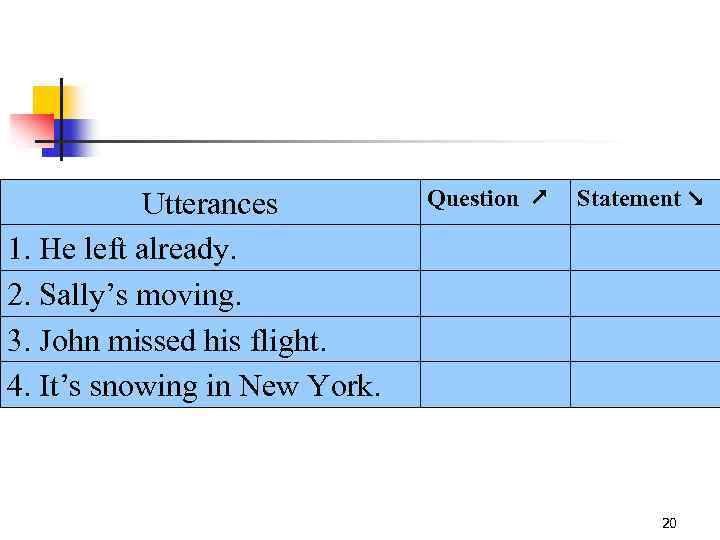
Utterances 1. He left already. 2. Sally’s moving. 3. John missed his flight. 4. It’s snowing in New York. Question Statement 20
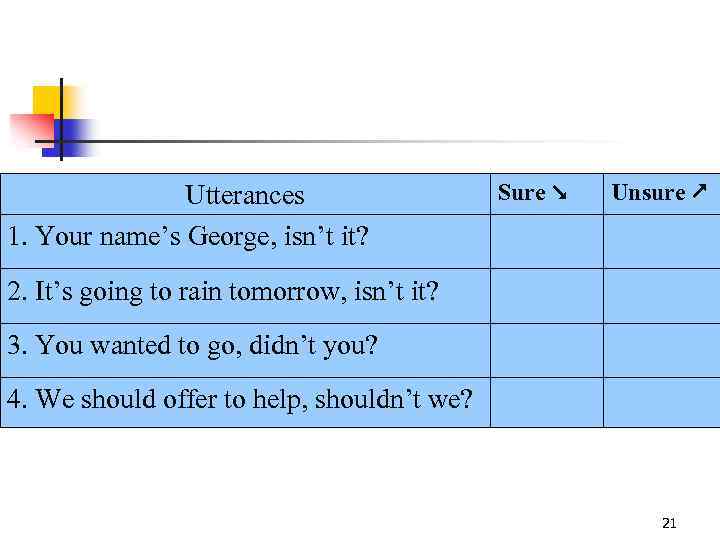
Utterances 1. Your name’s George, isn’t it? Sure Unsure 2. It’s going to rain tomorrow, isn’t it? 3. You wanted to go, didn’t you? 4. We should offer to help, shouldn’t we? 21
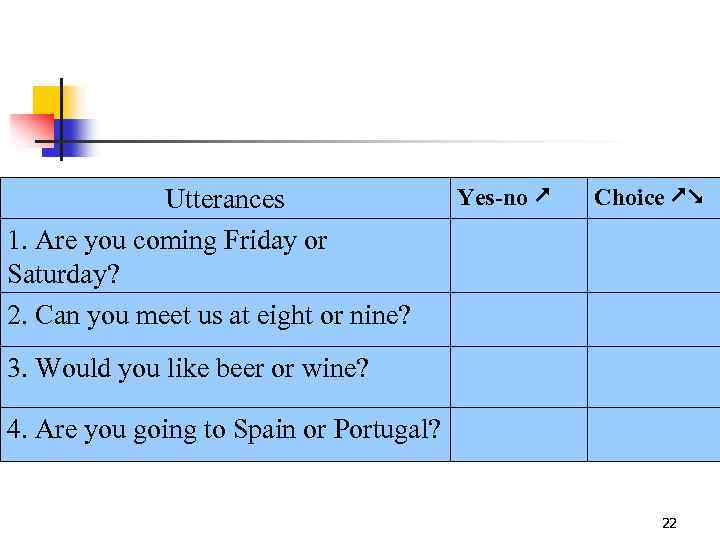
Utterances 1. Are you coming Friday or Saturday? 2. Can you meet us at eight or nine? Yes-no Choice 3. Would you like beer or wine? 4. Are you going to Spain or Portugal? 22
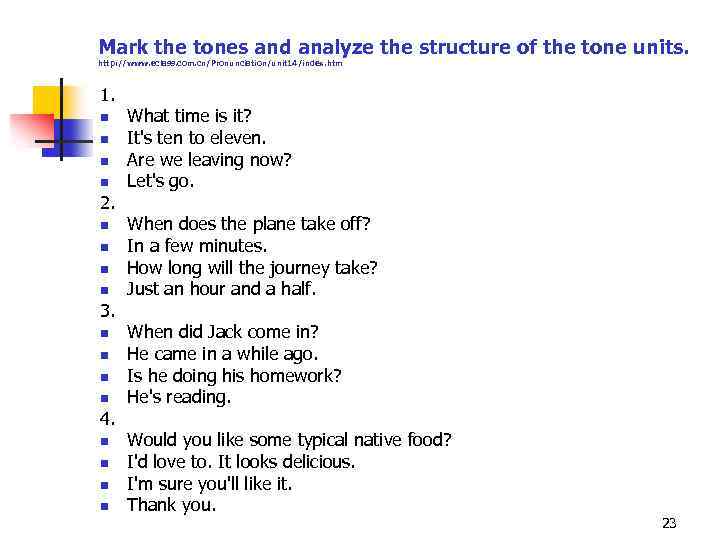
Mark the tones and analyze the structure of the tone units. http: //www. eclass. com. cn/Pronunciation/unit 14/index. htm 1. n n 2. n n 3. n n 4. n n What time is it? It's ten to eleven. Are we leaving now? Let's go. When does the plane take off? In a few minutes. How long will the journey take? Just an hour and a half. When did Jack come in? He came in a while ago. Is he doing his homework? He's reading. Would you like some typical native food? I'd love to. It looks delicious. I'm sure you'll like it. Thank you. 23
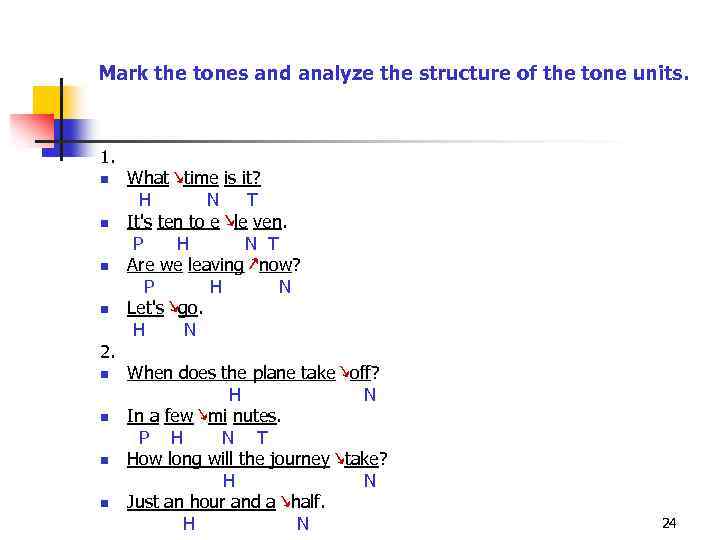
Mark the tones and analyze the structure of the tone units. 1. n n 2. n n What ↘time is it? H N T It's ten to e ↘le ven. P H N T Are we leaving ↗now? P H N Let's ↘go. H N When does the plane take ↘off? H N In a few ↘mi nutes. P H N T How long will the journey ↘take? H N Just an hour and a ↘half. H N 24
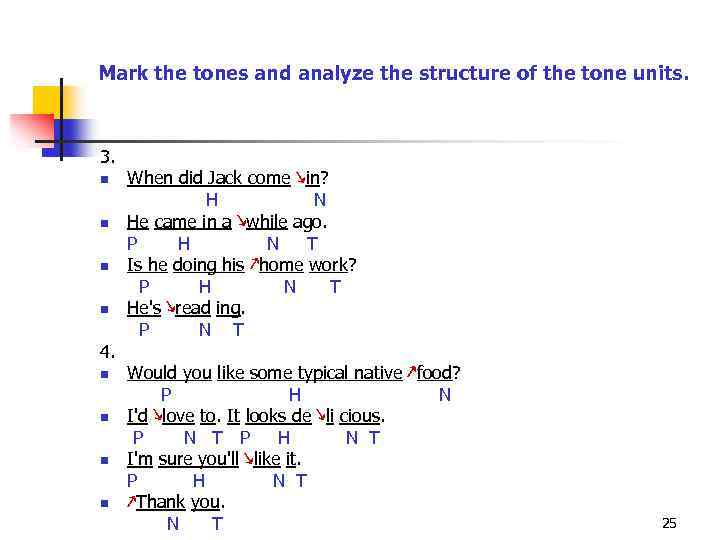
Mark the tones and analyze the structure of the tone units. 3. n n 4. n n When did Jack come ↘in? H N He came in a ↘while ago. P H N T Is he doing his ↗home work? P H N T He's ↘read ing. P N T Would you like some typical native ↗food? P H N I'd ↘love to. It looks de ↘li cious. P N T P H N T I'm sure you'll ↘like it. P H N T ↗Thank you. N T 25

Listening for information (1) Listening for the intonation in communication 26
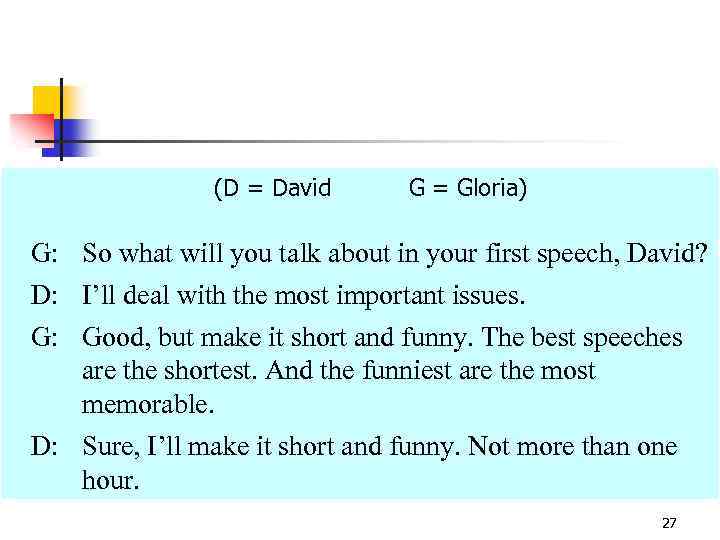
(D = David G = Gloria) G: So what will you talk about in your first speech, David? D: I’ll deal with the most important issues. G: Good, but make it short and funny. The best speeches are the shortest. And the funniest are the most memorable. D: Sure, I’ll make it short and funny. Not more than one hour. 27
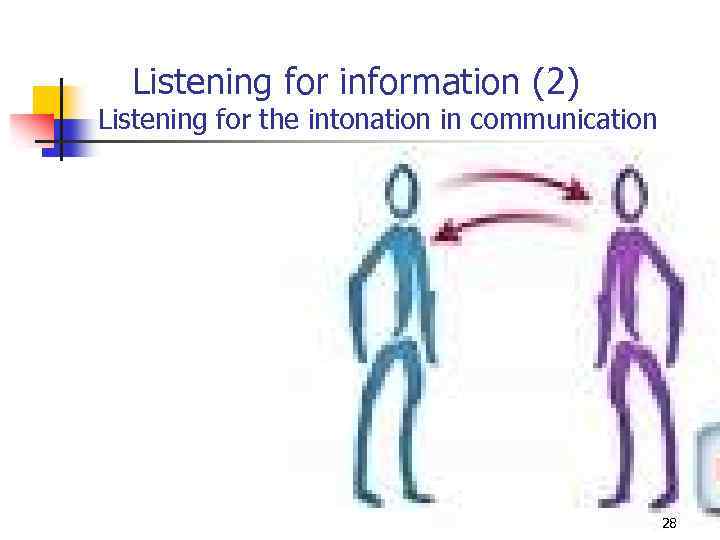
Listening for information (2) Listening for the intonation in communication 28

(D = David n n n n n G = Gloria) G: It's hot and sticky! Is it always as hot as this here in summer? D: I thought you’d be used to hot weather. Didn’t you use to work in Mexico City? Temperatures get pretty high there, don’t they? G: But it’s much drier there, so I didn’t mind the heat so much. The nights are cooler too, because the temperature drops quite a lot when the sun sets. D: I see. What about the winters in Mexico? Are they the same as here in Guangzhou? G: Oh no, the winters here are much milder. It’s far colder in Mexico. You have to wear a lot of extra clothes. D: Just like in Beijing. G: Oh no…not nearly as cold as that! Beijing must be one of the coldest cities in the world in winter. D: Well, it’s all very different form England, isn’t it? G: Yes, that’s certainly true. The English climate is much milder. 29 And much more changeable, too.
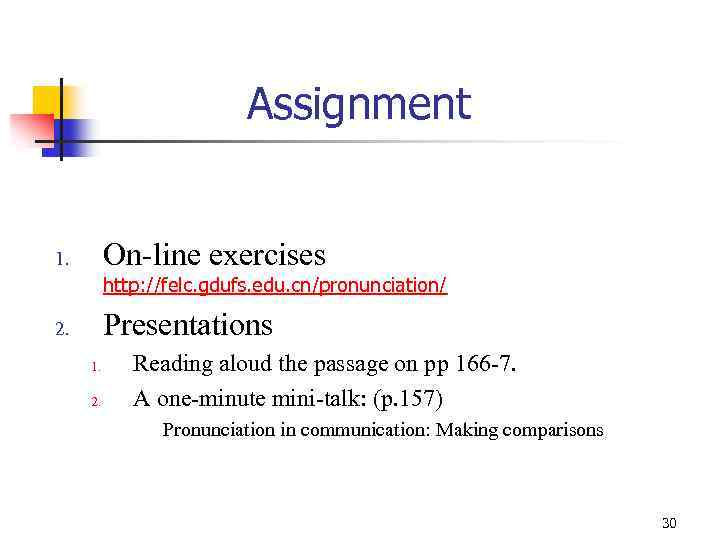
Assignment On-line exercises 1. http: //felc. gdufs. edu. cn/pronunciation/ Presentations 2. 1. 2. Reading aloud the passage on pp 166 -7. A one-minute mini-talk: (p. 157) Pronunciation in communication: Making comparisons 30

恭 贺 新 禧 31
интонация_китайский универ.ppt